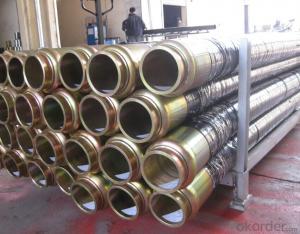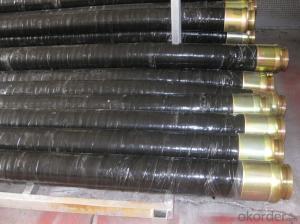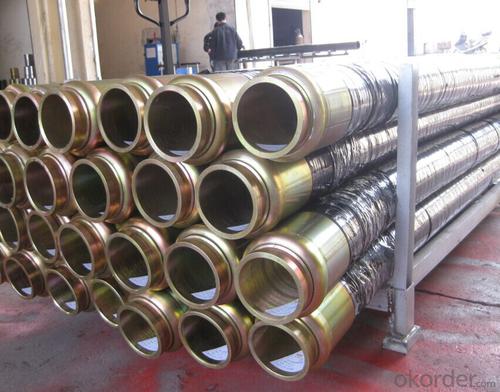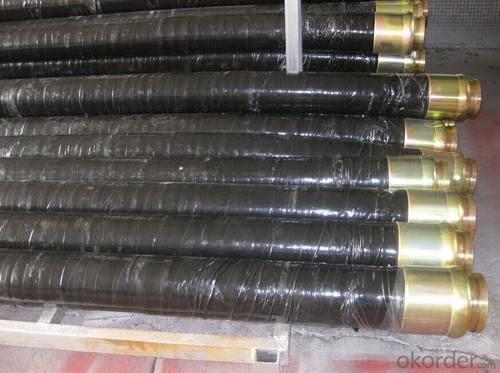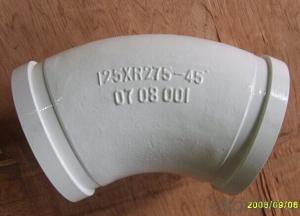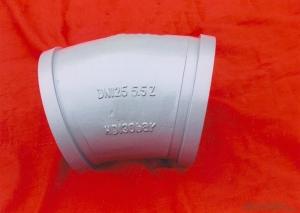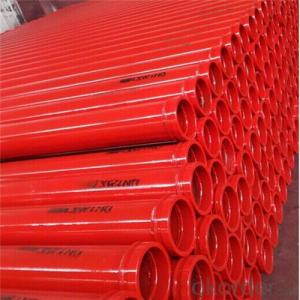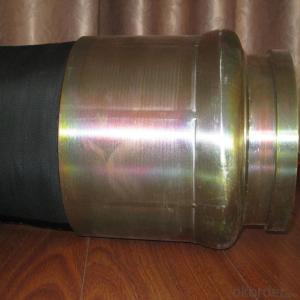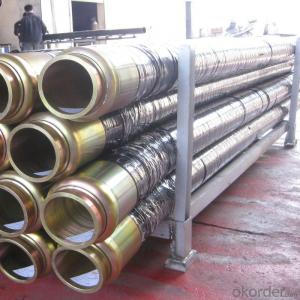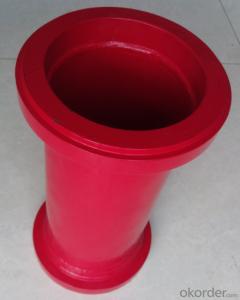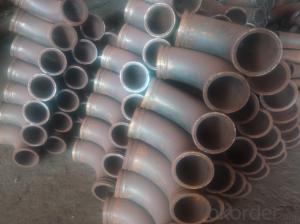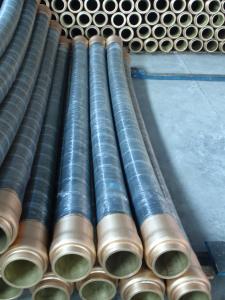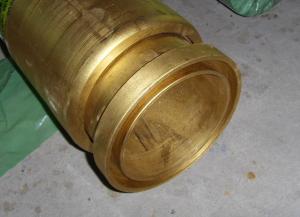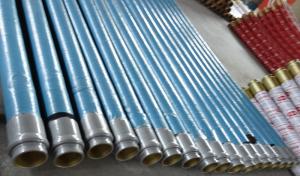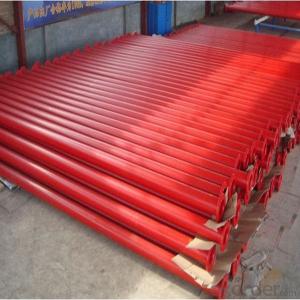Rubber End Hose With Two Side Couplings Working Pressure 85 Bar 5M*DN150
- Loading Port:
- Shanghai
- Payment Terms:
- TT OR LC
- Min Order Qty:
- 10 pc
- Supply Capability:
- 5000 pc/month
OKorder Service Pledge
OKorder Financial Service
You Might Also Like
Product Description:
The 5m*dn150 rubber end hose with two side couplings, normally the hoes is made by NR and reinforced by four layer steel wire, and the two couplings at each side are made by steel material No.ST52, 20#, 37MN5, with hot treatment according to customer’s requests, and also package in bundles or nude packing directly put into container.
Scope of Application of the pipes
The 5m*dn150 rubber end hose is a concrete delivery for combined use with other concrete pipelines in concrete placement operations. It can be widely used in the construction of various types of concrete structures like industrial and civil buildings, bridges, roads, and other types of infrastructure.
This end hose can only be used in concrete construction operations, but not in any other operations, like dragging, moving, or hoisting heavy articles or personnel. The end hose is also not allowed to be used in any location where any combustible or explosive material exists or a cave-in may occur.
Product Advantages:
OKorder's 5m*dn150 rubber end hose Channels are durable, strong, and safety. We are the biggest group in this business filed and the majority resources are under our control, which is make sure the delivery time and qualified products, meanwhile we have more than 20 overseas branches our people will go to visit customer very fast for more convenient communication.
Main Product Features:
· Premium quality
· Prompt delivery & seaworthy packing (5-10 days)
Reliable performance
Easy to weld
High safety.
· Professional Service
· Competitive pricing
Measuring of wall thickness from the outside
Low purchase cost
FAQ:
Q1: How long about delivery time?
A1: Normally we keep the raw materials for old customers and sometime we also keep stock products to make sure delivery time in any emergency cases.
Q2: How do we guarantee the quality of our products?
A2: We have established an advanced quality management system which conducts strict quality tests at every step, from raw materials to the final product. At the same time, we provide extensive follow-up service assurances as required.
Q3: How soon can we receive the product after purchase?
A3: Within three days of placing an order, we will book the vessel for goods. The specific shipping date is dependent upon international and government factors, but is typically 7 to 30 workdays.
Q4: If we can produce some pipes according to customers request?
A4: Yes, we can produce Concrete Placing Boom according to the difference country situations to make it suitable to the market and customers. We have very professional technical team to make the design.
Q5: How to make a quick resolution for after service?
A5: OKorder and our manufacture both have overseas branches all-around of world, if needed.
Name | Specifications | Application | Flange diameter | Remarks |
Rubber hose | DN125*3000 | Concrete pump | 148/DN157mm | |
Rubber hose | DN150*3000 | Concrete pump | 148/DN157mm | |
High pressure | DN125*3000 | Concrete pump | 148/DN157mm | Two layers of steel wire |
High pressure | DN125*3000 | Concrete pump | 148/DN157mm | Four layers of steel wire |
High pressure | DN125*4000 | Concrete pump | 148/DN157mm | |
High pressure | DN150*3000 | Concrete pump | 175mm | |
| DN80*5000 | Mortar pump mini conctete pump | 98mm | |
| DN80*6000 | Mortar pump mini conctete pump | 98mm | |
| DN100*5000 | Mortar pump mini conctete pump | 124mm | |
| DN76*6000 | Fine stone concrete pump mini conctete pump |
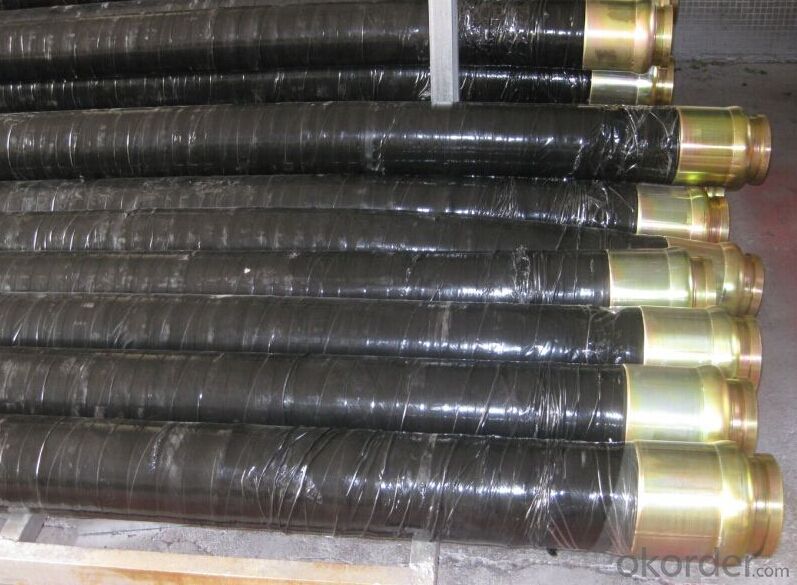
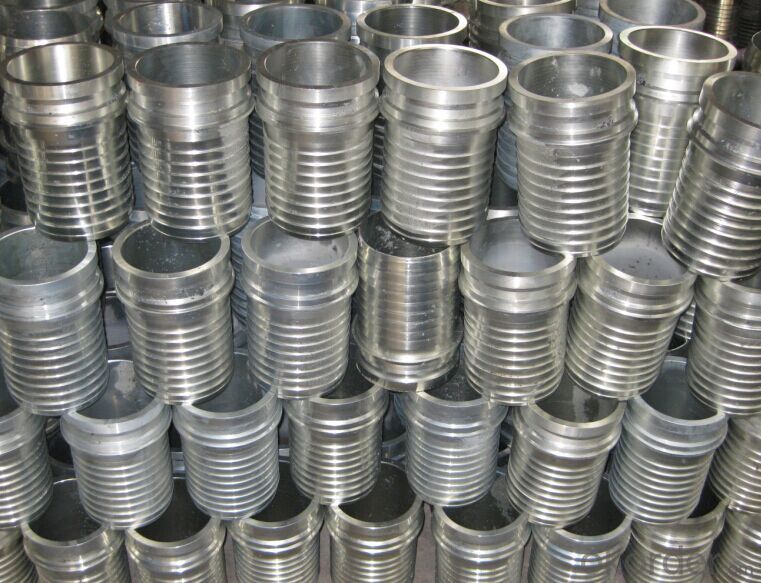
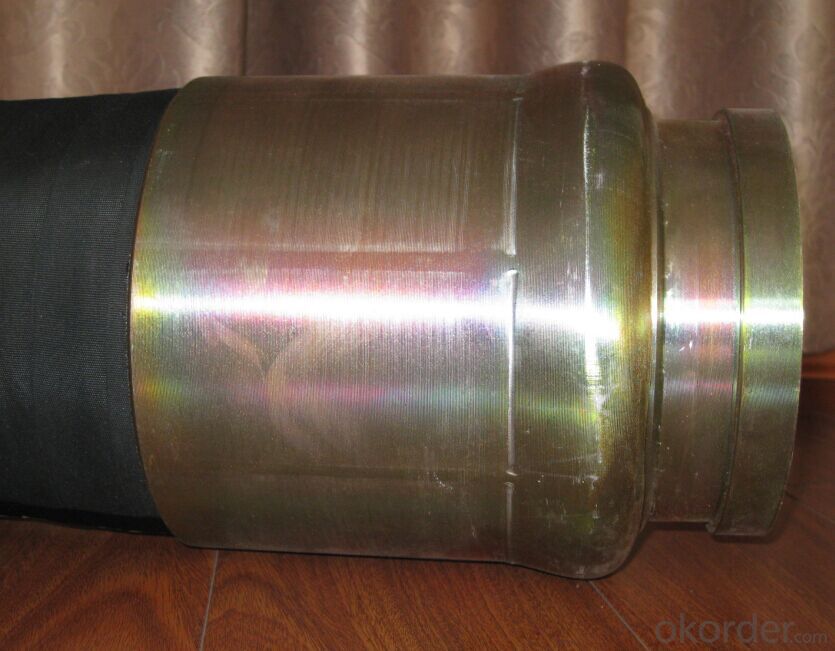
- Q: Are there any specific recommendations for the inspection and testing of concrete pump spare parts?
- Yes, there are specific recommendations for the inspection and testing of concrete pump spare parts. Firstly, it is important to visually inspect the spare parts for any signs of damage, such as cracks, dents, or excessive wear. This can be done by carefully examining the parts and looking for any irregularities or abnormalities. Next, it is recommended to conduct non-destructive testing (NDT) to ensure the integrity and quality of the spare parts. NDT methods such as ultrasonic testing, magnetic particle testing, or dye penetrant testing can be used to detect any hidden defects or flaws in the parts. These tests can help identify potential issues that may affect the performance or safety of the concrete pump. In addition, it is advisable to check the dimensions and tolerances of the spare parts to ensure they meet the manufacturer's specifications. This can be done using precision measuring tools and comparing the measurements with the required specifications. Any deviations should be noted and addressed accordingly. Furthermore, functional testing should be conducted to ensure the spare parts are operating as intended. This can involve installing the parts in the concrete pump and carrying out various tests to verify their functionality and performance. For example, the pump can be tested for its flow rate, pressure, and efficiency to ensure optimal performance. Lastly, it is crucial to follow the manufacturer's guidelines and recommendations for the inspection and testing of concrete pump spare parts. These guidelines may provide specific instructions and procedures for inspecting and testing each type of spare part, ensuring that they are done accurately and safely. It is important to consult the manufacturer's documentation and seek professional advice if needed.
- Q: What are the layout requirements of concrete pump for building engineering?
- The setting of concrete pump should be steady and firm, with heavy vehicle running condition
- Q: How often should concrete pump control valves be inspected and replaced?
- Concrete pump control valves should be inspected regularly, at least once every six months, to ensure they are in proper working condition. However, the frequency of replacement depends on various factors such as usage, maintenance, and wear and tear. It is recommended to replace control valves as soon as signs of significant damage or malfunctioning are observed during the inspections.
- Q: What is the difference between concrete pump and ground pump?
- The pump is actually the day Linuo arm frame of concrete pump boom is known, a few day, after mixing through the boom pump, the efficiency is very high
- Q: Are there any specific guidelines for the transportation of concrete pump spare parts?
- Concrete pump spare parts have specific guidelines for transportation to ensure their safe arrival and immediate usability. Consider the following key guidelines: 1. Packaging: Adequate packaging is necessary to prevent damage during transportation. This may involve using sturdy boxes, crates, or pallets to protect parts from impacts and vibrations. 2. Labeling: Clearly label each package with its contents, including the specific part name and number. This facilitates easy identification and prevents confusion during transportation. 3. Handling: Handle spare parts with care to avoid mishandling or dropping, which could cause damage. It is recommended to use proper lifting equipment and follow safe handling practices to prevent excessive stress or force. 4. Securing: Properly secure packages to prevent movement or shifting during transportation. This can be achieved by using strapping, shrink-wrapping, or other suitable methods to keep packages in place. 5. Temperature control: If spare parts are temperature-sensitive, ensure proper temperature control during transportation. Extreme temperature variations can damage certain parts, so it's important to protect them accordingly. 6. Transportation mode: Select suitable transportation modes based on the size and weight of spare parts. For larger parts, flatbed trucks or specialized vehicles may be necessary to accommodate their size and weight. 7. Insurance: It's advisable to have proper insurance coverage for the transportation of concrete pump spare parts. This provides financial protection in case of unforeseen incidents or damages during transit. By adhering to these guidelines, concrete pump spare parts can be transported smoothly and safely, guaranteeing their intact delivery and immediate usability.
- Q: Are there any specific cleaning procedures for concrete pump spare parts?
- Yes, there are specific cleaning procedures for concrete pump spare parts. It is important to ensure that these parts are clean and free from any dirt or debris to maintain their efficiency and longevity. Here are some general guidelines to follow when cleaning concrete pump spare parts: 1. Safety First: Before starting the cleaning process, make sure to wear appropriate personal protective equipment (PPE) such as gloves and safety goggles to protect yourself from any potential hazards. 2. Disconnect Power: Before cleaning any electrical or mechanical parts, make sure to disconnect the power supply to avoid any accidents. 3. Remove Excess Dirt: Use a brush or a dry cloth to remove any loose dirt or debris from the surface of the spare parts. This will make the cleaning process more effective. 4. Use Appropriate Cleaning Solution: Depending on the type of spare parts and the level of dirt, choose an appropriate cleaning solution. Mild detergents or soapy water are generally safe to use. Avoid using harsh chemicals or solvents that may damage the parts. 5. Scrub and Rinse: Dip a clean cloth or sponge into the cleaning solution and gently scrub the spare parts to remove any stubborn dirt or stains. Rinse the parts thoroughly with clean water to remove any residue of the cleaning solution. 6. Dry Completely: After rinsing, make sure to dry the spare parts thoroughly using a clean cloth or by air-drying. Moisture can lead to rust or corrosion, so it is important to ensure complete drying. 7. Lubricate Moving Parts: If the spare parts have any moving components, such as bearings or gears, apply an appropriate lubricant to ensure smooth operation. This will help prevent wear and tear and extend the lifespan of the parts. 8. Regular Maintenance: To keep the concrete pump spare parts in optimal condition, it is recommended to perform regular cleaning and maintenance. Inspect them periodically for any signs of damage or wear and replace them if necessary. By following these specific cleaning procedures, you can effectively clean and maintain the concrete pump spare parts, ensuring their reliability and longevity.
- Q: How often should carbide wear plates be replaced in a concrete pump?
- The frequency at which carbide wear plates should be replaced in a concrete pump depends on several factors, including the type and quality of the plates, the intensity of usage, and the specific conditions in which the pump operates. Carbide wear plates are designed to endure heavy wear and tear caused by the abrasive nature of concrete. Generally, they have a longer lifespan compared to traditional steel wear plates. However, they are not completely immune to deterioration and will eventually wear down over time. A good rule of thumb is to regularly inspect the wear plates and monitor their condition. If the plates show signs of significant wear, such as visible cracks, excessive erosion, or reduced performance in terms of concrete flow, it is time to consider replacing them. In some cases, wear plates may need to be replaced annually, while in others, they may last several years. To prolong the lifespan of carbide wear plates, proper maintenance and care are essential. This includes regularly cleaning the plates, ensuring proper lubrication of the pump, and avoiding excessive pressure or abuse during operation. Regular maintenance can help to extend the lifespan of the wear plates and reduce the frequency of replacements. It is always recommended to consult the manufacturer's guidelines or seek advice from a professional concrete pump technician to determine the specific replacement interval for carbide wear plates in a particular pump model. They will have the expertise and knowledge to provide accurate recommendations based on the specific conditions and usage of the concrete pump.
- Q: What is the purpose of a concrete pump piston?
- The purpose of a concrete pump piston is to provide the necessary pressure to push the concrete mixture from the hopper into the delivery pipeline. The piston is responsible for generating the force required to propel the concrete through the system, effectively transporting it to its intended destination. This is achieved by the reciprocating motion of the piston, which creates suction on one side and pressure on the other, enabling the concrete to be pushed forward. Overall, the concrete pump piston plays a crucial role in facilitating the efficient and continuous movement of concrete, making it an essential component in construction projects that require the precise and timely placement of concrete.
- Q: How often should hopper vibrators be inspected or replaced in a concrete pump?
- Hopper vibrators in a concrete pump should be regularly inspected to ensure their proper functioning and prevent any potential issues. The frequency of inspections or replacements may vary depending on several factors, including the intensity of use, operating conditions, and the manufacturer's recommendations. As a general guideline, it is advisable to inspect hopper vibrators at least once a year or every 500-600 hours of operation, whichever comes first. However, if the concrete pump is subjected to heavy use or operates in harsh environments, more frequent inspections may be necessary. During the inspection, the hopper vibrators should be checked for any signs of wear, damage, or loose connections. Additionally, the vibration intensity and frequency should be examined to ensure they are within the recommended range. Any issues identified during the inspection should be promptly addressed, either through repairs or replacements, to ensure the hopper vibrators continue to function optimally. Regular inspections and timely replacements of hopper vibrators are crucial to maintain the efficiency and reliability of a concrete pump. Neglecting these inspections can lead to decreased performance, increased downtime, and potentially costly repairs. Therefore, it is essential to follow the manufacturer's guidelines and consult with professionals to determine the appropriate frequency for inspections and replacements based on the specific circumstances of your concrete pump.
- Q: What is the function of a concrete pump remote control antenna?
- The primary role of a concrete pump remote control antenna is to establish a wireless connection between the remote control device and the concrete pump. This connection enables the operator to remotely manage various functions of the concrete pump, including initiating and terminating the pump, adjusting concrete speed and flow, and controlling boom movements. The antenna receives signals transmitted by the remote control device and transmits them to the concrete pump, enabling the operator to safely control the pump from a distance. By providing the operator with improved visibility of the pump and its surroundings, while maintaining complete operational control, this technology contributes to enhanced efficiency, accuracy, and safety at construction sites.
Send your message to us
Rubber End Hose With Two Side Couplings Working Pressure 85 Bar 5M*DN150
- Loading Port:
- Shanghai
- Payment Terms:
- TT OR LC
- Min Order Qty:
- 10 pc
- Supply Capability:
- 5000 pc/month
OKorder Service Pledge
OKorder Financial Service
Similar products
Hot products
Hot Searches
Related keywords
